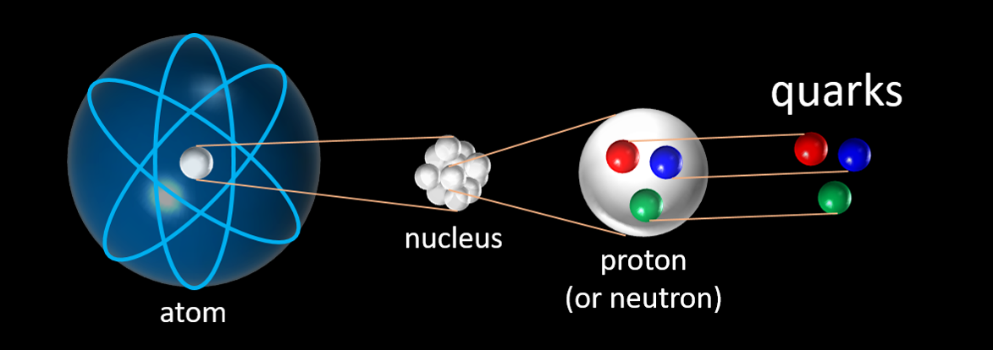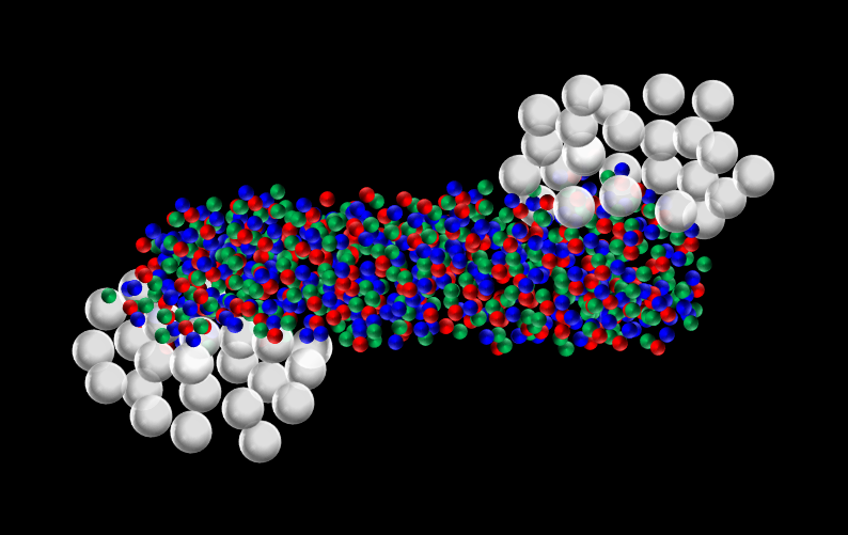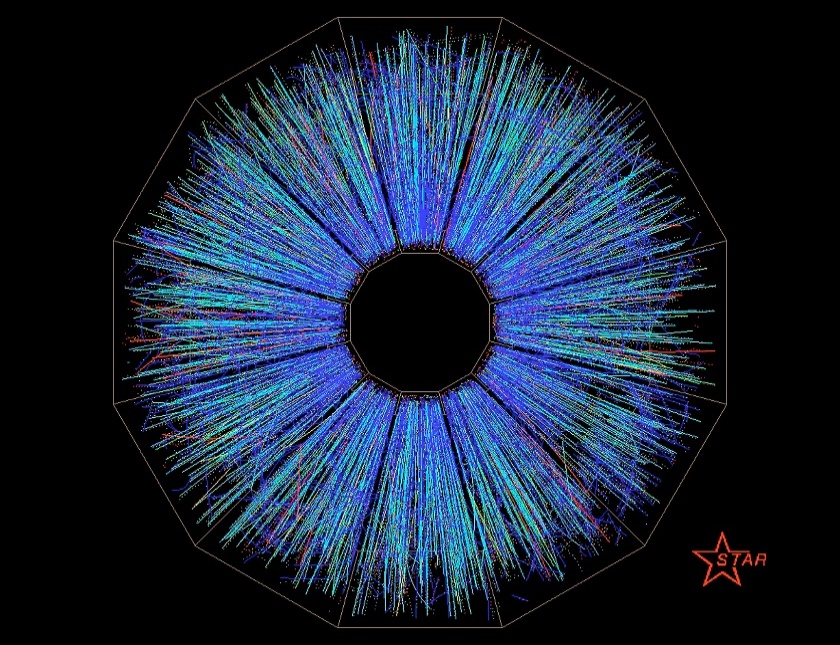The Behavior of the Primordial Universe
You sit outside on a beautiful spring morning accompanied by your favorite hot beverage to watch the sunrise. As you enjoy the brisk morning air, your mind begins to wander. You begin to think about the particularly delicious beverage in your hand and, for some reason, you think about its composition. What’s it made of? Suddenly you think about what makes up the air you are breathing, the chair you are sitting on, the Earth and the Sun themselves. What makes you up? What is everything made of? Such a simple question has stirred the curiosity and imagination of mankind for millennia. The ancient Greeks had the word atomos, meaning indivisible and saw all material around them as being composed of tiny pieces of indivisible material. This view, that everything in the universe is made of some indivisible pieces of stuff, still holds true today, just at much smaller distances than the ancients ever imagined. I study the behavior of matter that is composed of these indivisible building blocks of our universe. In order to discuss my work, I will first provide a general historical introduction to my field and introduce some key physical ideas along the way.
The quest to find the fundamental building blocks of the universe has come a long way since the ancient Greeks. Cells were discovered in the 1600’s and atoms were discovered in the 1800’s. In the early 1900’s the atom was found to contain a small very dense nucleus which contains nearly 100 percent of the atom’s mass and has a positive electric charge. Atoms are composed of this positive nucleus and a cloud of negatively charged particles called electrons. By the 1940’s scientists had found that the nucleus is composed of two types of smaller particles: protons, which have positive electric charge, and neutrons, which are electrically neutral. Up until the 1960’s the electron, proton, and neutron were understood to be the indivisible pieces of our universe. Let’s take a moment to understand a few things about protons and neutrons.
For some sense of the distances involved, let us zoom in on the proton and neutron. For those of us used to the English system of units, let me say that one meter is about one yard, or about 3 feet and 3 inches long. If we chop the meter into one-hundred pieces this is called a centimeter, which is about the size of a sugar cube. If we cut the meter into one-thousand pieces we have a millimeter, the thickness of about ten pieces of paper. The diameter of a human hair is about the thickness of a piece of paper, or about a tenth of a millimeter. Along the edge of this piece of paper we could stack ten human blood cells edge to edge. So the diameter of a blood cell is about a hundredth of a millimeter. How do we get to the size of an atom?
An atom is about two-hundred thousand times smaller than the diameter of a blood cell. So along the edge of a piece a paper we could stack ten blood cells edge to edge, or we could stack two-million atoms. As I said earlier, most of the mass of an atom has been found to reside in its nucleus. The atomic nucleus is about a thousand times smaller than the atom itself. So about two-billion atomic nuclei could fit along the edge of a piece of paper. This estimate depends on the element, as the size of a hydrogen nucleus, which consists of only a single proton, is just the size of a proton. While a gold nucleus, which consists of 79 protons and 118 neutrons, has a diameter roughly 13 times larger than a proton. That’s a lot of protons in a small space.
As mentioned before, electrons are particles which carry negative electric charge, while protons carry positive electric charge, and neutrons are electrically neutral. Two protons will repel each other, and two electrons will repel each other, while one electron near one proton will attract each other. We can summarize this by saying that two particles with the same sign of electric charge will repel while two particles with opposite signs of electric charge will attract each other. So we can think of the electrons that are buzzing around the atomic nucleus as being attracted to the positive charge in the atomic nucleus. But why does the atomic nucleus not fly apart since there are protons very close to one another?
In the late 1960’s and through the 1970’s the protons and neutrons of the atomic nucleus were found to be made of even smaller particles. These particles are called quarks and gluons. They have a new type of charge called color charge. Electrically charged particles can feel an attraction or repulsion depending on the charge of nearby particles. But interactions between particles which have color charge are a bit more complicated. The interaction of multiple quarks makes it seem as though a rubber band is connecting them. As the quarks move further away from one another they are pulled back towards each other. They are forever trapped to their fellow quarks. This has profound consequences as a single quark cannot, and has not, been observed. Gluons also interact with quarks and other gluons via color charge. The interaction of quarks and gluons is the strongest force known to date. And it is the interaction between quarks from different protons and neutrons in a nucleus which can hold the nucleus together, despite the immense electrical repulsion of the protons in a nucleus.
Figure 1: Quarks make up every proton and neutron in our universe.
The current state of the art method to study subatomic matter is to accelerate particles to very high speeds and collide these fast-moving particles either into a fixed slab of material or head on with another beam of fast moving particles. The atomic nucleus was discovered by shooting helium nuclei into a thin sheet of gold. While the quark was experimentally discovered by colliding electrons head on with protons and neutrons.
Starting in the year 2000, collisions between two gold nuclei travelling at near the speed of light were underway at the Relativistic Heavy Ion Collider, RHIC, at Brookhaven National Lab in the state of New York. Relativistic meaning the colliding objects are moving near the speed of light, heavy meaning nuclei containing many protons and neutrons, and ion meaning the electrons have been removed from around the nucleus. The goal of heavy ion collisions was to create fleeting droplets of matter that is composed of quarks and gluons, the quark gluon plasma.
Figure 2: A cartoon of the collision of two heavy nuclei. The white spheres are protons and neutrons. The nucleus on the left is travelling to the left and the nucleus on the right is travelling to the right. Where the nuclei collided, we see a lot of quarks.
The collision of two gold nuclei travelling at relativistic speeds creates a short-lived state of matter which is not described by atoms, atomic nuclei, protons, or neutrons. But rather, the properties of this state of matter are given by the physics concerning quarks and gluons. This is the matter which filled our entire universe for the first microseconds after the big bang. Hence, the behavior of the quark gluon plasma provides an understanding of our early universe. Currently, relativistic collisions at RHIC and the large hadron collider, LHC, are the only way for mankind to produce this primordial plasma.
The properties of the quark gluon plasma, QGP, are pieced together from the aftermath of collisions between heavy nuclei. The entire collision occurs over distances close to the size of a nucleus. At first the matter in the collision is hot enough to be described by the physics of quarks and gluons, and can consequently be called the QGP stage of the collision. This is the stage of the collision which I study. The quark gluon plasma then expands rapidly and cools. At some point the collided material will not be hot enough to have QGP and consequently the quarks will become bound to other quarks. This leads to a shower of particles which are composed of multiple quarks, such as protons and neutrons. This shower of multi-quark particles reaches large detectors which were built around the collision area. The detectors catalog the properties of these particles. From this data, physicists can reconstruct the properties of each stage of the collision.
Figure 3: End on view of a collision of two heavy nuclei at RHIC. This is actual data from one of the detectors in the particle accelerator. All the colored lines represent particles that flew out from the collision of two Gold nuclei. Taken from: https://www.bnl.gov/rhic/news2/news.asp?a=1052&t=pr
The physics governing particles which possess color charge, the quarks and gluons, is called quantum chromo-dynamics, or QCD for short. QCD is what tells us that quarks cannot escape one another, this property is called confinement as the quarks are confined to be with other quarks. QCD also tells us that when quarks are further from each other they are more strongly attracted to one another and that the reverse is also true. When quarks are closer together their interaction becomes weaker. This property is called asymptotic freedom, since, as the quarks get closer and closer they act more and more like freely moving particles.
From our understanding of QCD, physicists first thought that the material produced immediately after relativistic collisions of heavy nuclei, the QGP, would be a weakly interacting system of quarks and gluons due to asymptotic freedom. The scientific community has since learned that the observed properties of this material indicate a system that is strongly interacting.
Two of the main properties which lead to this conclusion are an observed flowing of the material and the rate at which energy is spread out in the material. Just like water flows differently than honey, an observed flow of the QGP requires the quarks and gluons to interact strongly, not as though they are free. In addition, physicists have found that a fast-moving particle near the edge of the QGP looks like a jet of material, like the jet of water from the nozzle of a garden hose. But a fast-moving particle that traverses the QGP looks like a slight ripple. Think of spraying the jet of water from our garden hose through a tub of water. This indicates that the QGP can dissipate energy quickly and is therefore made of strongly interacting particles.
My research concerns the theoretical understanding of the quark gluon plasma. Just to clarify, by theoretical I don’t mean any old thing someone thinks of, no simple guess. A physical theory is based in mathematics and must pass many tests, such as correctly describing observations in nature. But I did say that QCD describes the interactions of quarks and gluons and QCD has been around since the 1970’s, so why don’t we know everything about the QGP? It turns out it is easier to calculate properties of a few, and I mostly mean two, weakly interacting quarks and gluons. But as I look at collisions between three or more quarks and gluons the calculations become very difficult very fast. Calculations in QCD also become incredibly difficult if I need the quarks and gluons to be strongly interacting. And very difficult means either the calculations at some point cannot be done in a reasonable time frame, on current computers, or we don’t have the mathematical framework to correctly do the calculation.
What tools does this leave a physicist to describe the properties of the quark gluon plasma? I make use of mathematical tools which have been around for over a century. The tools were developed by a man named Boltzmann to handle large systems of interacting particles. I use a computer code to simulate the motion of interacting quarks and gluons according to Boltzmann’s mathematical tools. For simplicity, I only look at a system of interacting gluons. This is still useful as we have reason to believe gluons are more important than the quarks during the QGP stage of the collision.
In order to describe an interacting system of gluons, and not the air in this room, I describe the collisions between particles in the QGP using complicated rules from QCD. In my simulation, the chance for any two or any three gluons to collide is given by QCD. Additionally, the angles at which the gluons leave a given collision are dictated by QCD. A particular collision between gluons is also sensitive to any charged particles around the colliding gluons, an effect I will call screening. I also account for screening in my simulation.
My work also accounts for another purely quantum phenomenon. Imagine you are playing a game of billiards. You take a shot and the cue ball collides with another ball when instantly a third ball emerges from the collision of the other two. This cannot happen in our macroscopic world but happens all the time in the subatomic quantum world. I include the ability not only for two particles to bounce off each other, but for two particles to collide and three to emerge, or for three to collide and only two emerge. These phenomena are called particle production and annihilation.
One of my main results is that a larger flow of the QGP can be achieved due to including screened particle production and annihilation collisions. The flow of the QGP when including such collisions is larger than when I either ignore the screening effect or ignore particle production and annihilation. Additionally, I found that the method of including the screening has a large impact on the collisions between gluons and hence on the properties of the QGP.
Let’s say your hot beverage was too hot, so you added some cold water to the cup. Within some time, all of the liquid in the cup would again be at a common temperature, even though there was a large temperature difference between the hot liquid and the cold water. In physics, we call such ideas equilibrium. I have also found that the QGP can reach an equilibrium faster for the case of including both screening and particle annihilation and production than for the case where the gluons just bounce off each other. This is again extremely sensitive to the method of screening.
My research has highlighted the significance of the screening effect and particle production and annihilation in the dynamics of the QGP. This prompts immediate work to better understand both the screening of color charged particles and the particle production and annihilation of gluons. As both of these ingredients depend on assumptions and approximations.
Dustin Hemphill, PhD, 2017


